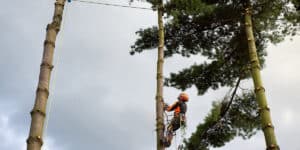By: Shelby McCullough| Published: January 16, 2023

Removing a leaning tree might seem like an overwhelming project at first. Many homeowners, such as in Geneva and other nearby areas, decide just to leave it alone because they don’t want to deal with the cost, don’t like the inconvenience, or enjoy the tree being there. However, cutting a leaning tree might be your best option, depending on the situation. Our team at McCullough Tree Service in Orlando weighs in on the issue below.
What Causes a Tree To Lean?
If you’re dealing with leaning tree problems, you might wonder what caused them in the first place. A tree may start leaning for a wide variety of reasons—some structural and some environmental. Here are some of the most common factors contributing to a leaning tree:
- Strong winds: Florida has its fair share of gale force throughout the year. While these high winds can snap tree branches and make yard work a nightmare, they can push against trees and cause them to lean.
- Heavy rains: Extended periods of heavy rainfall can saturate the ground around a tree’s root system, affect its center of gravity, and result in leaning.
- Diseases: A leaning tree may suffer diseases or pest infestations that cause it to tilt. The weaker its roots, the more likely it is to lean.
- Inadequate sunlight: Some trees grow crooked because of lack of sunshine. If nearby trees or tall structures block the light source, a sapling will often develop a lean.
Is It Dangerous To Leave a Leaning Tree?
Leaning trees aren’t necessarily hazardous if they are healthy and a safe distance away from structures and people. However, a tree might be dangerous if it leans due to damaged roots or adverse weather conditions. Consult a certified arborist to see if cutting a leaning tree is the best course of action.
An unhealthy leaning tree is cause for concern. It’s more likely to fall over and do the following:
- Break electrical lines and cause a power outage
- Damage personal property, such as vehicles and houses
- Injure animals or people nearby
When Should You Cut Down a Leaning Tree?
In some instances, tree bracing is the best way to treat a leaning tree. This works well for smaller tree diameters. However, tree bracing won’t work for large leaning trees.
You’ll want to cut down a leaning tree if it leans toward a building, sidewalk, roadway, or power lines, as this can cause significant damage. You should also consider tree removal if the leaning tree shows signs of damage, such as a hollow trunk or exposed root system. An experienced tree surgeon can inspect the tree for you, identify any issues, and help you find the best solution.
Let Our Team at McCullough Tree Service Handle Your Leaning Tree
At McCullough Tree Service, we offer a full suite of reliable tree care services in Geneve, FL, and the surrounding area. Our certified arborists know the best time to have a tree removed, how to effectively use escape paths, and other essential tips for cutting a leaning tree. To learn more about our top-quality services and get a free estimate, call us today at (407) 734-5854!

